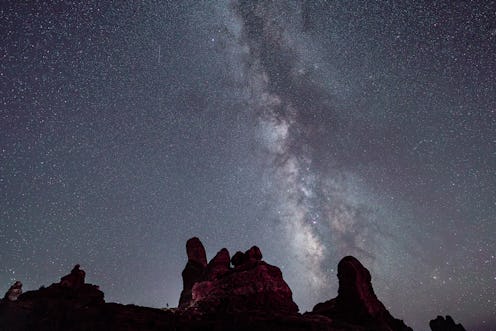
If you're living in the U.S., then you already know that today's solar eclipse hype has come and gone, leaving you with that vaguely sad, empty feeling that you get on Sunday nights or the day after Christmas. I mean, when is the next time you're going to make a total fool of yourself dancing to "Total Eclipse Of The Heart" on the sidewalk in front of hundreds of other office workers gawking at the sky, amirite? The good news is, you can fill your eclipse-less heart with something else to look forward to: other space events like the solar eclipse that are coming up, and every bit as much worth getting amped up about.
In the words of my good (one-sided, unrequited) friend Neil deGrasse Tyson, "Total Solar Eclipses occur somewhere on Earth every two years, or so. So just calm yourself when people tell you they're rare". And while that somewhat diminishes the coolness of this being the first visible total solar eclipse we've had in the U.S. since 1979 (and the last we'll have until 2024), he does make a good point: phenomenons like this are actually a lot more commonplace than people think. The key is being able to anticipate them — and, if necessary, traveling the necessary distance to experience them.
If you find yourself burning with an ~astronomical~ curiosity about cool upcoming space phenomenon in the next few years, then here are the events you should start looking forward to now.
Draconids Meteor Shower
From Oct. 6 through Oct. 10, peaking on October 8, 2017, the annual Draconids Meteor Shower will be producing up to 10 meteors per hour. This celestial event is most visible in the early evening, and people anywhere in the world have a shot at viewing it if they are far enough away from light pollution. The meteor shower will be radiating out of the constellation Draco, in the far northern sky close to the Little and Big Dippers.
Blue Moon & Lunar Eclipse
On January 31, 2018, we'll experience the first Blue Moon since 2015. Typically occurring once every two to three years, a Blue Moon is essentially when there are two Full Moons in the same month; this particular Blue Moon won't be just a Full Moon, but a Supermoon as well. It will be the second and last of the two Supermoons we'll see in 2018 — when the moon is closest to the Earth, and appears much more vibrantly in the night sky.
Some regions will also experience a lunar eclipse on this same night — you can check on this lunar eclipse map to see if you're in the path of it. Despite being called a "Blue Moon," due to the nature of the eclipse — with the moon in the shadow of the Earth — it will appear a blood red color to the naked eye.
Partial Solar Eclipse
OK, OK, a partial solar eclipse is not nearly as exciting as a total solar eclipse, but still pretty cool if you happen to be in the regions of Chile, Argentina, or Antarctica (you do you, guys), where you'll get a pretty cool show on February 18, 2018. A few months later, on July 13, 2018, there will be yet another partial solar eclipse visible in the southern most regions of Australia and Antarctica.
Transit Of Mercury Across The Sun
For the last time until 2039, viewers with telescopes that are outfitted with proper solar lenses will be able to view Mercury in transit across the face of the sun on November 11, 2019. The phenomenon is relatively rare, only happening once or twice in a lifetime. It will be visible from some portions of North America, and all throughout South and Central America, as well as parts of Mexico, Europe, the Middle East, and Africa.
The Northern Lights
I know. Wow, what an original idea! But honestly, if you haven't seen the Northern Lights, or yet, make it a priority this year or the next. Iceland Air has all kinds of travel deals across the U.S., including in the months of October through March, when the Northern Lights are most visible to the naked eye. If you're looking for another travel destination, you can also try Scandinavia, Alaska, and Canada — just make sure you're in the right region to get a glimpse of them before you go (and allow some extra days, because they're hard to see on cloudy nights).
Total Solar Eclipse In The U.S.
If you're in the U.S. and you somehow slept through Monday's solar eclipse, the good news is that you'll have a lot less time to wait than the 38 years that have passed since the last one — the next total solar eclipse in the U.S. will take place on April 8, 2024. Unlike Monday's eclipse, which ran in a southeastern direction from Oregon to South Carolina, this eclipse will run in a northeastern direction, from Texas to Maine. You can get a glimpse of the path of totality in advance on this map here. It never hurts to plan ahead!
Images: Getty Images (4)